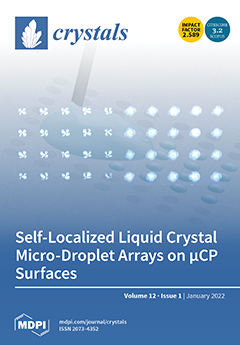The flavone–chalcone hybrid compound, (
E)-6-bromo-3-(3-(2-methoxyphenyl)-3-oxoprop-1-enyl)-4H-chromen-4-one (
3), was synthesized and its three dimensional structure was identified by X-ray crystallography. The compound
3, C
19H
13BrO
4, was crystallized in the triclinic space group P-1 with the
[...] Read more.
The flavone–chalcone hybrid compound, (
E)-6-bromo-3-(3-(2-methoxyphenyl)-3-oxoprop-1-enyl)-4H-chromen-4-one (
3), was synthesized and its three dimensional structure was identified by X-ray crystallography. The compound
3, C
19H
13BrO
4, was crystallized in the triclinic space group P-1 with the following cell parameters: a = 8.2447(6) Å; b = 8.6032(6) Å; c = 11.7826(7) Å; α = 92.456(2)°; β = 91.541(2)°; γ = 106.138(2)°; V = 801.42(9) Å
3 and Z = 2. In an asymmetric unit, two molecules are packed by a pi–pi stacking interaction between two flavone rings that are 3.790 Å apart from each other. In the crystal, two hydrogen bonds form inversion dimers and these dimers are extended along the
a axis by another hydrogen bond. Hirshfeld analysis revealed that the H–H (34.3%), O–H (19.2%) and C–H (16.7%) intermolecular contacts are the major dominants, while the C–O (6.7%) and C–C (6.5%) are minor dominants. When HCT116 cells were treated with various concentrations of hybrid compound
3, reduced cell viability and induced apoptosis in HCT116 cells were observed in a dose-dependent manner. The treatment of HCT116 colon cancer cells with compound
3, decreased the intracellular glutathione (GSH) levels and generated a reactive oxygen species (ROS). In silico docking experiments between the compound
3 and glutathione S-transferase (GST) containing glutathione were performed to confirm whether the compound
3 binds to glutathione. Their binding energy ranged from −6.6 kcal/mol to −5.0 kcal/mol, and the sulfur of glutathione is very close to the Michael acceptor regions of the compound
3, so it is expected that they would easily react with each other. Compound
3 may be a promising novel anticancer agent by ROS generation through glutathione depletion.
Full article





